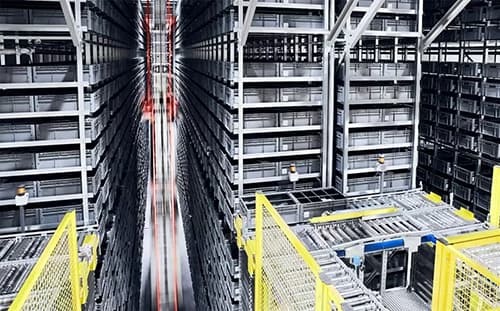Advancements in technology, such as robotics, automation systems, and artificial intelligence, have enabled the development of highly automated warehouses. A fully automated warehouse typically involves the integration of various technologies and systems to perform functions such as receiving, storing, picking, packing, and shipping with minimal human intervention.

Here are some key components and technologies that contribute to the automation of a warehouse:
1. Automated Storage and Retrieval System (ASRS): ASRS systems utilize robotic cranes or shuttles to automatically store and retrieve items from designated storage locations. These systems can optimize space utilization, enhance inventory management, and enable fast and accurate order fulfillment.
2. Automated Guided Vehicles (AGVs): AGVs can autonomously transport goods within the warehouse, eliminating the need for manual material handling. They can navigate through the facility using sensors and follow predefined routes or dynamically adjust their paths based on real-time information.
3. Conveyor Systems: Automated conveyor systems can move items along a predetermined path, facilitating the seamless flow of goods within the warehouse. They can be integrated with other automation technologies, such as AGVs or picking robots, to ensure efficient material handling.
4. Robotics and Pick-and-Place Systems: Advanced robotics systems, including robotic arms and grippers, are employed for tasks such as order picking, sorting, packing, and palletizing. These robots can handle a wide range of items and improve productivity and accuracy in warehouse operations.
5. Warehouse Management System (WMS): A WMS is a software application that controls and manages various aspects of warehouse operations. It coordinates the activities of different automation systems, optimizes inventory storage and picking strategies, and provides real-time information for efficient decision-making.
6. Internet of Things (IoT) and Sensors: IoT devices and sensors can be deployed throughout the warehouse to collect and transmit data on parameters such as inventory levels, equipment status, temperature, and security. This data can be used for monitoring, predictive maintenance, and optimizing overall warehouse operations.
While full automation is possible, the level of automation implemented in a warehouse depends on factors such as the type of goods being handled, order volumes, space constraints, budget, and operational requirements.
By Amy

Add: RM. 1204, BLDG.-2, NEW SPACE DEVELOPMENT CENTER, NO.126 TIANYUAN RD., JIANGNING, NANJING, CHINA.
Copyright 2025@ Jiangsu Kingmore Storage Equipment Manufacturing Co., Ltd All Rights Reserved.
Sitemap
| Blog
| Xml
| Privacy Policy
 Network Supported
Network Supported